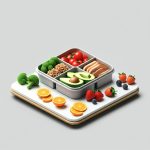The goal is set, and it feels monumental: lose 50 pounds in six months. Maybe it’s a number your doctor recommended, a personal milestone you’ve been chasing, or the key to feeling more energetic and confident in your own skin. It sounds daunting, but let’s reframe it. This isn’t about a punishing, short-term sprint; it’s a completely achievable marathon built on smart, sustainable habits.
You can absolutely do this. The key isn’t a magic pill or a trendy, restrictive diet you’ll abandon in two weeks. It’s about understanding the science, creating a realistic plan, and being consistent. This guide will walk you through every step of that plan, not with fluff, but with actionable strategies grounded in proven principles.
Your Journey at a Glance
Thinking about the path ahead? Here are the core principles we’ll unpack:
- The Pace: Losing 50 pounds in 26 weeks breaks down to about 1.9 pounds per week—a safe, effective, and sustainable rate of weight loss.
- The Engine: The entire process is fueled by a consistent calorie deficit. You need to burn more energy than you consume, day in and day out.
- The Fuel: Success starts on your plate. We’ll focus on nutrient-dense whole foods that keep you full and energized, not deprived.
- The Accelerator: A combination of cardio for calorie burning and strength training for metabolism-boosting is your most powerful exercise strategy.
- The Foundation: Don’t overlook the fundamentals. Proper hydration, quality sleep, and stress management are non-negotiable for success.
- The Mindset: Consistency will always beat intensity. This is about progress, not perfection.
Is Losing 50 Pounds in 6 Months Actually a Good Goal?
Before we dive into the “how,” let’s tackle the “if.” Is this a healthy and realistic target?
In short, yes. The Centers for Disease Control and Prevention (CDC) recommends a gradual weight loss of 1 to 2 pounds per week for the most sustainable, long-term results.
- 50 pounds ÷ 26 weeks (6 months) ≈ 1.9 pounds per week
This number falls squarely within that healthy range. It’s ambitious enough to keep you motivated but realistic enough to achieve without resorting to extreme measures that can harm your metabolism, lead to muscle loss, and result in immediate rebound weight gain.
The Simple Math of a Calorie Deficit
Weight loss boils down to one core principle: a calorie deficit. This means your body uses more calories for energy than you provide it through food and drink.
Think of it like a bank account. Calories are currency. To lower your balance (body weight), you need to spend (burn) more than you deposit (eat).
A general rule of thumb is that one pound of fat is equivalent to roughly 3,500 calories. To lose about two pounds per week, you’d need a weekly deficit of 7,000 calories, or a daily deficit of 1,000 calories. This sounds like a lot, but you can achieve it with a balanced approach:
- Reduce 500 calories from your daily food intake.
- Burn 500 calories through physical activity.
This combination is far more manageable and effective than trying to achieve the full deficit through diet or exercise alone.
Your Plate Is Your Power: Building a Diet That Works
You can’t out-train a bad diet. Nutrition is the cornerstone of your weight loss journey. But this isn’t about eating bland, boring food forever. It’s about making smart swaps and focusing on what you add to your diet, not just what you take away.
Ditch the “Diet” Mentality for Whole-Food Fundamentals
Forget fad diets that ban entire food groups. They’re often unsustainable and can lead to nutritional deficiencies. Instead, build your meals around nutrient-dense, whole foods. These are foods that are as close to their natural state as possible.
- Lean Proteins: Chicken breast, fish, turkey, lean beef, eggs, tofu, lentils, and Greek yogurt. Protein is crucial for satiety (feeling full) and preserving muscle mass while you lose fat.
- Fiber-Rich Vegetables: Broccoli, spinach, bell peppers, Brussels sprouts, and leafy greens. They are low in calories but high in volume and nutrients, helping you feel full.
- Fruits: Berries, apples, and oranges provide natural sweetness, vitamins, and fiber.
- Complex Carbohydrates: Oats, brown rice, quinoa, and sweet potatoes. These provide sustained energy without the blood sugar spike of processed carbs.
- Healthy Fats: Avocado, nuts, seeds, and olive oil. Fats are essential for hormone function and can increase satiety.
Master the Macros: A Simple Guide
Don’t get bogged down in complex macronutrient ratios unless you enjoy it. A simple, balanced approach is best:
- Prioritize Protein: Aim to include a source of lean protein in every meal. This helps control hunger and supports your metabolism.
- Fill Half Your Plate with Veggies: This is the easiest trick in the book. Before you add anything else, load up on non-starchy vegetables.
- Be Smart with Carbs and Fats: Use complex carbs and healthy fats as complements to your meal, not the main event. A cupped-hand portion of carbs and a thumb-sized portion of fats is a good visual guide.
Practical Tools for Portion Control
Even healthy foods have calories. For the first few weeks, getting a handle on portion sizes is a game-changer.
- Use a Food Scale: It might feel tedious at first, but weighing your food for a week or two is the most eye-opening way to understand what a true serving size looks like.
- Switch to Smaller Plates: A psychological trick that works. The same amount of food looks more satisfying on a smaller plate.
- Read Nutrition Labels: Pay attention to the “servings per container.” That bag of chips you thought was 200 calories might actually be two or three servings.
Move Your Body: The Smart Way to Exercise for Fat Loss

While diet drives weight loss, exercise accelerates it, reshapes your body, and provides immense mental and physical health benefits. A smart plan includes both cardio and strength training.
The One-Two Punch: Cardio and Strength Training
Thinking you need to spend hours on the treadmill is a common mistake. The most effective approach combines two types of exercise.
1. Cardiovascular Exercise (Cardio): This is what burns a significant number of calories in a single session.
- Examples: Brisk walking, running, cycling, swimming, or using an elliptical machine.
- High-Intensity Interval Training (HIIT): This involves short bursts of all-out effort followed by brief recovery periods (e.g., 30 seconds of sprinting, 60 seconds of walking). HIIT is incredibly time-efficient for burning calories.
2. Strength Training: This is what builds and maintains metabolically active muscle. - Examples: Lifting weights, using resistance bands, or bodyweight exercises like push-ups, squats, and lunges.
- Why it’s a “secret weapon”: The more muscle you have, the more calories your body burns at rest. This revs up your resting metabolic rate, making it easier to lose weight and keep it off.
The journey of how to lose 50 pounds is a marathon, not a sprint, built on consistent, smart choices in both the kitchen and the gym.
Creating a Weekly Workout Schedule You Can Stick To
Consistency is everything. Aim for a plan that feels challenging but doable. The American Heart Association recommends at least 150 minutes of moderate-intensity aerobic activity or 75 minutes of vigorous activity per week, plus at least two days of strength training.
Here’s a sample weekly schedule:
- Monday: Strength Training (Full Body)
- Tuesday: 30-45 minutes of Moderate-Intensity Cardio (e.g., brisk walk or cycling)
- Wednesday: Strength Training (Full Body)
- Thursday: 20-minute HIIT session
- Friday: Strength Training (Full Body)
- Saturday: Active Recovery (e.g., long walk, yoga, or a hike)
- Sunday: Rest
Beyond Diet and Exercise: The Four Pillars of Lasting Change
If you nail nutrition and exercise but ignore your lifestyle, you’re making the journey much harder than it needs to be. These four habits are the unsung heroes of sustainable weight loss.
1. Hydration: Your Secret Weapon for Appetite Control
Water is essential for metabolism and often helps manage hunger. Sometimes when you feel hungry, you’re actually just thirsty.
- The Goal: Aim for at least eight 8-ounce glasses a day, but don’t be afraid to aim for up to a gallon, especially on active days.
- The Trick: Carry a large reusable water bottle with you everywhere. Seeing it is a constant reminder to drink up.
2. Sleep: The Overlooked Fat-Loss Accelerator
Poor sleep can sabotage your best efforts. When you’re sleep-deprived, your body produces more ghrelin (the “I’m hungry” hormone) and less leptin (the “I’m full” hormone).
- The Goal: 7-9 hours of quality sleep per night.
- The Trick: Create a relaxing bedtime routine. Turn off screens an hour before bed, keep your room cool and dark, and try to go to bed and wake up around the same time every day.
3. Stress Management: Taming the Cortisol Beast
Chronic stress floods your body with the hormone cortisol. Elevated cortisol can increase appetite, drive cravings for unhealthy food, and encourage your body to store fat, particularly around your midsection.
- The Goal: Find healthy outlets to process stress.
- The Trick: You don’t need a two-hour yoga class. Just 5-10 minutes of meditation, deep breathing exercises, a short walk outside, or listening to calming music can make a huge difference.
4. A Word on Alcohol: The Empty Calorie Trap
Alcohol can be a major roadblock for two reasons:
- It’s packed with “empty” calories: A single craft beer or glass of wine can have 150-250 calories with no nutritional benefit.
- It lowers your inhibitions: After a couple of drinks, that late-night pizza suddenly seems like a great idea.
You don’t have to become a teetotaler, but drastically cutting back on alcohol will make hitting your calorie goals infinitely easier.
Navigating the Journey: How to Stay Motivated and Break Through Plateaus
The path to losing 50 pounds won’t be a perfectly straight line down. There will be great weeks and tough weeks. Preparing for the mental side of the journey is just as important as planning your meals.
If You Don’t Measure It, You Can’t Manage It
Tracking your progress helps you stay accountable and see what’s working.
- Weigh Yourself Consistently: Pick one day a week, weigh yourself first thing in the morning, and log it. Don’t obsess over daily fluctuations—they’re normal. Focus on the weekly trend.
- Use a Measuring Tape: Sometimes the scale won’t budge, but you’re still losing inches as your body composition changes (losing fat and gaining muscle). Measure your waist, hips, and chest once a month.
- Take Progress Photos: A picture is worth a thousand words. A side-by-side comparison after one or two months can be incredibly motivating.
The Plateau Problem: Why It Happens and How to Fix It
At some point, you will hit a weight loss plateau. It’s a normal part of the process. As you lose weight, your body requires fewer calories to function. What created a deficit at 250 pounds might be your maintenance level at 220 pounds.
When the scale stalls for more than two weeks, try one of these strategies:
- Re-evaluate Your Calories: Your needs have changed. Recalculate your daily target and make a small adjustment (e.g., reduce by 100-200 calories).
- Increase Your Intensity: Add an extra 10 minutes to your cardio, lift heavier weights, or try a new HIIT routine.
- Look at “Calorie Creep”: Are you still measuring your olive oil, or are you just “eyeballing” it now? Small, untracked calories can add up and stall your progress.
Your First Week Starts Now: A Simple Action Plan
Reading this guide is a great first step, but action is what creates change. Don’t try to overhaul your entire life overnight. Start with these five simple steps this week.
- Calculate Your Calorie Target: Use a free online TDEE (Total Daily Energy Expenditure) calculator to get a baseline. Subtract 500-750 from that number to find your initial daily goal.
- Plan Your Meals for Tomorrow: Don’t leave it to chance. Decide what you’re having for breakfast, lunch, and dinner. Make sure each meal includes a source of protein and vegetables.
- Schedule Two 30-Minute Walks: Put them in your calendar like any other important appointment. This is your starting point for physical activity.
- Get a Large Water Bottle: Fill it up and keep it on your desk or with you throughout the day. Your only goal is to finish it.
- Tell Someone Your Goal: Share your goal with a supportive friend or family member. Accountability is a powerful motivator.
Losing 50 pounds in six months is more than just a number on a scale. It’s a journey that will teach you about your body, your resilience, and your strength. Be patient with yourself, celebrate the small victories along the way, and remember that every healthy choice is a step in the right direction. You’re building a healthier, stronger, and more energetic future for yourself, one day at a time.
- Bento Tray Revolutionizes Organized Meal Transport and Presentation - December 10, 2025
- Meal Plans for Busy Schedules That Make Healthy Eating Easy - December 10, 2025
- Where to Buy Bento Boxes for Healthy, Organized Meals - December 9, 2025










